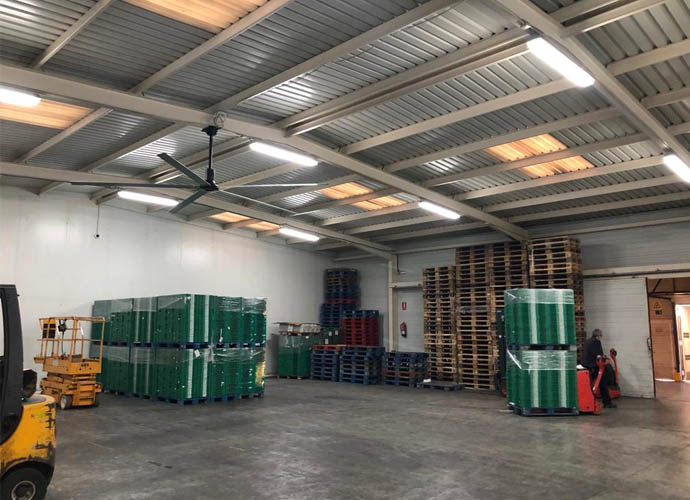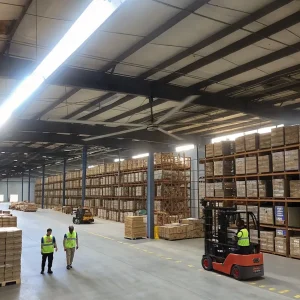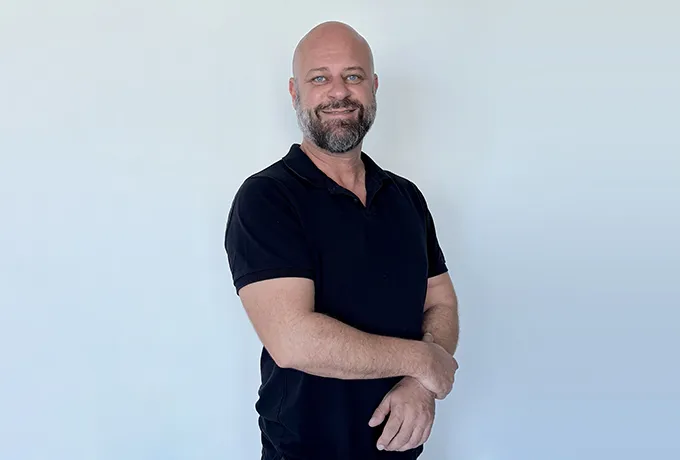Your energy bills are climbing, and your space still doesn’t feel cool enough. That’s frustrating. If your air conditioning is working harder than it should, it’s not just wasting electricity—it’s wasting your money. Ceiling fans, especially industrial HVLS fans, might be the smartest solution you’re not using yet.
Ceiling fans help lower your electric bill by circulating cool air, allowing you to raise your thermostat setting while maintaining comfort. When properly used with air conditioning, ceiling fans and HVLS fans reduce energy consumption and improve temperature control in both residential and industrial spaces.

Ceiling fans don’t cool the air itself—but they do cool you. That’s because a fan increases वायु प्रवाह, which speeds up the evaporation of sweat from your skin. This natural cooling effect means you can raise your थर्मोस्टेट temperature by 4–8°F and still feel just as comfortable.
When used correctly, running a ceiling fan in conjunction with your एयर कंडीशनर reduces your overall ऊर्जा के उपयोग. The air feels cooler, so the AC compressor doesn’t have to work as hard. And since AC units consume far more power than ceiling fans, this leads to significant energy savings.
| Cooling Method | Energy Use per Hour | Notes |
|---|---|---|
| Central Air Conditioner | 2,000–3,500 watts | High cost, mechanical cooling |
| Ceiling Fan (Energy Star) | 15–90 watts | Low cost, improves perceived comfort |
| HVLS Fan in Warehouse | 200–1000 watts | Efficient for large-volume air movement |
Ceiling fans are especially effective when placed in rooms where people spend a lot of time. Just remember: fans cool people, not spaces—so don’t use them in empty rooms.
का उपयोग करते हुए ceiling fans to cool your home can result in an average of 5%–15% savings on your electricity bill during hot months. When combined with smart thermostat use, ceiling fans allow for energy-efficient comfort without constant reliance on your AC unit.
Here’s a quick breakdown:
Raising your thermostat setting by 4°F can lower air conditioning costs by up to 30%
एक Energy Star ceiling fan uses 60% less energy than traditional models
For commercial buildings, industrial एचवीएलएस पंखे reduce cooling costs by 15%–40%
के अनुसार Department of Energy, ceiling fans help save approximately $20–$70 per year in residential settings—and significantly more in commercial or industrial environments where cooling costs are higher.
If you’re running large fans in warehouses or manufacturing facilities, our Warehouse HVLS Fan Solutions are specifically designed to enhance airflow and reduce energy waste बड़े पैमाने पर.

Warehouse HVLS Fan Solutions
एचवीएलएस के लिए खड़ा है उच्च-मात्रा, निम्न-गति. These are not your average living room ceiling fans—they’re large-diameter fans (often 8–24 feet wide) designed to move massive volumes of air at low rotational speeds. Their purpose is to provide widespread हवा परिसंचरण while using minimal energy.
Here’s why HVLS fans are a better option for industrial and commercial environments:
Circulate air throughout large open spaces like gyms, factories, or गोदामों
Lower the temperature of a room by 4–7°F without extra AC
सुधार वायु गुणवत्ता by reducing stagnant zones and humidity
Help save on both गर्म और ठण्डा करना costs year-round
Integrate easily with renewable energy systems like solar
Compared to traditional फर्श पंखे या पेडस्टल पंखे, HVLS units operate silently, last longer, and cover wider areas without wasting electricity. One HVLS fan can replace 10–20 smaller units while using कम ऊर्जा कुल मिलाकर।
You can explore fan performance charts and specifications on our एम650 सीरीज एचवीएलएस पंखे page, engineered for high performance and energy efficiency.
One of the most effective ways to lower energy usage in a large facility is by using ceiling fans with your HVAC system—not instead of it. HVLS fans don’t replace your AC, but they reduce the need for it to run at full capacity.
एचवीएलएस पंखे बनाते हैं लगातार वायु प्रवाह across large zones, which allows for:
Higher thermostat settings
Faster distribution of ठंडी हवा
Fewer AC cycles per hour
Reduced wear on compressors and fans
The result? Lower energy bills and improved equipment lifespan.
This approach is especially useful in औद्योगिक वातावरण, कहाँ air conditioning costs are notoriously high. For example, in a 30,000 square foot facility, adding just two HVLS fans can reduce cooling load by up to 40%, even on hot summer days.
Want to see this in action? Visit our Commercial Cooling Systems page for case studies and performance data.
हाँ-ceiling fans allow energy savings all year long, not just in summer.
में winter, warm air rises and accumulates near the ceiling, especially in large facilities with high ceilings. HVLS fans can run clockwise at low speed, gently redistributing गर्म हवा down to the occupied level. This balances the temperature of the room and reduces reliance on the furnace or central heating.
Winter: Reduce heating costs by 10–30%
Spring/Fall: Minimize energy waste by using fans instead of AC
Summer: Lower cooling bills while maintaining comfort
Ceiling fans are a true energy-saving investment for facilities that value year-round comfort and control over ऊर्जा की खपत.
Optimizing fan direction and thermostat setting is crucial to maximize savings. Here’s a quick reference guide:
| Season | Fan Direction | Thermostat Temperature | परिणाम |
|---|---|---|---|
| Summer | Counterclockwise | 76–78 °F | Cools room with less energy |
| Winter | Clockwise (Low) | 66–68 °F | Circulates warm air downward |
| Empty Room | Turn Off Fan | — | Avoids unnecessary power draw |
अगर आप कर रहे हैं using a ceiling fan, be sure to match the rotation to the season. Many fans now come with smart controls that automate this process based on temperature, humidity, and ऊर्जा दक्षता targets.
In large-scale facilities, smart HVLS systems can be integrated with a थर्मोस्टेट, occupancy sensors, and even solar energy generation to create a fully responsive and energy-efficient air conditioning system.
For a complete integration overview, check out our guide on HVLS Smart Control Technology.
If you’re transitioning to solar energy or other sustainable sources, fans are perfect partners. Unlike compressors or chillers, most छत के पंखे—even large HVLS models—consume low to moderate wattage and can easily be powered by rooftop panels.
Let’s compare:
| Appliance Type | Average Power Use | Compatible with Solar? |
|---|---|---|
| Central AC Unit | 2000–4000 watts | High load, not ideal |
| HVLS Fan (18 ft diameter) | 500–1000 watts | Easily powered |
| Pedestal or Box Fan | 75–120 watts | Compatible |
| Ceiling Fan (Home) | 20–60 watts | Ideal match |
By combining solar with fans to keep your space cool, facilities reduce grid dependency, earn tax credits, and improve ROI on their कुशल ऊर्जा upgrades.
To dive deeper into solar integrations, read our full guide on HVLS Fans and Renewable Energy.
Yes. If you’re leaving a fan running in an unoccupied space, you’re not cooling anyone—just wasting electricity. Even प्रशंसक ऐसा नहीं करते use much energy individually, over time they add to your utility bill without providing any benefit.
के लिए energy conservation, always:
Turn off fans when rooms are empty
Use smart switches or timers
Consider occupancy sensors in large औद्योगिक स्थान
छत पंखा स्थापना should always include proper controls, especially in areas where air conditioning costs are a concern. You can read more about smart fan management in our Temperature Control Guide.
To maximize savings, look for Energy Star-certified ceiling fans. These models are engineered to move more air per watt and include advanced पंखे की गति controls. Features to prioritize:
Efficient पंखा का ब्लेड with aerodynamic design
Smart reverse mode (for winter)
Fan with adjustable speed and timers
Whisper-quiet operation for commercial spaces
For industrial environments, एचवीएलएस छत पंखे are ideal. They outperform smaller fans by covering large volumes with low power. HVLS fans come in a variety of sizes, depending on the कमरे का आकार या pipe or hose size for specialized facilities.
If you’re unsure which size fits your facility, contact our team or explore the Buying Guide for HVLS Fans.
Let’s wrap up with clear, actionable steps. Here’s how to save energy, improve comfort, and extend HVAC life—all using fans:
उपयोग छत के पंखे to raise AC settings by 4–8 °F
Reverse fan direction in winter to recirculate गर्म हवा
Turn off fans when not in use to prevent energy waste
Select the right fan for your needs (residential, commercial, or एचवीएलएस)
Pair with curtains or blinds to block heat from sunlight
Perform an annual home energy or facility energy audit
Combine fans with solar energy for sustainable cooling
चुनना बड़ा पंखा solutions (like the M750) for खुले स्थान
With the proper airflow, even hot summer days become manageable without overworking your HVAC.

गोदाम में बड़ा छत पंखा
Do ceiling fans reduce electricity bills in every type of building?
Yes. From homes to large औद्योगिक सेटिंग्स, ceiling fans reduce the load on cooling systems, which in turn reduces energy bills. Industrial एचवीएलएस पंखे offer especially high ROI.
What is the best temperature setting when using a ceiling fan?
Set the थर्मोस्टेट to 78 °F in summer and 68 °F in winter. Let the fan assist in air mixing so your HVAC system won’t have to work harder than it needs.
Can fans be used in rooms with high ceilings or odd layouts?
बिल्कुल। एचवीएलएस पंखे are designed for औद्योगिक अनुप्रयोग and large, open layouts like warehouses, sports centers, and school gymnasiums.
How do fans contribute to energy efficiency in winter?
By redistributing rising heat, fans help maintain even temperatures. You can save on energy costs by letting your furnace run less often.
What’s better: axial, centrifugal, or HVLS fans?
It depends. Axial fans work well for ventilation. केन्द्रापसारी पंखे are best for ducts and fans and blowers. But for cooling large volumes, एचवीएलएस छत पंखे are the top choice.
Here’s a recap of the most important points to remember:
Ceiling fans improve perceived comfort, allowing higher thermostat settings
HVLS fans are ideal for commercial and industrial buildings
उपयोग fan direction settings properly for both summer and winter savings
Turn off fans in empty spaces to avoid waste electricity
उपयोग ऊर्जा सितारा or smart-controlled models for the best results
Pair fans with renewable energy systems to lower your electric footprint
Select the right size and type of fan based on your room or facility layout
Contact a professional to help you choose the right industrial fan for your needs
For long-term energy efficiency and workplace comfort, fans are a low-cost, high-impact solution—especially when you upgrade to HVLS systems designed for modern, sustainable buildings.
Ready to improve your airflow and reduce energy costs? Start here:
Explore the full HVLS Product Series or request a quote from our engineering team for a custom airflow plan.

हाय मैं हूँ माइकल डेनियलसनविन्डस फैन्स के सीईओ, इंजीनियरिंग और डिजाइन उद्योग में 15 से अधिक वर्षों के अनुभव के साथ। मैं यहाँ जो कुछ भी सीखा है उसे साझा करने के लिए हूँ। यदि आपके पास कोई प्रश्न है, तो बेझिझक मुझसे किसी भी समय संपर्क करें। आइए साथ मिलकर आगे बढ़ें!